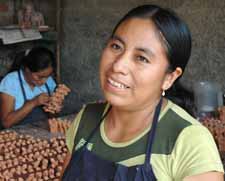Canadian Mennonite
Volume 12, No. 10
May 12, 2008
Focus on Fair Trade
A short history of fair trade
National Correspondent
 |
“All things good and fair” are at the heart of fair trade, says Ingrid Heinrichs Pauls, education and media coordinator for Ten Thousand Villages, which markets fair trade products, handicrafts and coffee. “Our main focus is not profit; it’s about creating income for people who would otherwise not have a fair income,” and treating those people “the way we expect to be treated when doing business.”
That includes ensuring gender equality, no child labour and caring for the environment.
FINE—a group of four worldwide fair trade networks—defines fair trade as “a trading partnership, based on dialogue, transparency and respect, which seeks greater equity in international trade. It contributes to sustainable development by offering better trading conditions to, and securing the rights of, marginalized producers and workers—especially in the South.”
Ten Thousand Villages had its beginning in 1946 when Edna Ruth Byler served with MCC in Puerto Rico with her husband. She met women doing quality needlework, but they had nowhere to sell their work and were living in poverty. Byler took some of the needlework home to Akron, Pa., and began selling it out of the trunk of her car. Soon, she began selling items made by artisans in Haiti and the West Bank. The endeavour proved to be so successful that MCC eventually took it over.
“It started from just a tiny little vision to make a little bit of difference,” Heinrichs Pauls says, “and now it continues to grow phenomenally.” Ten Thousand Villages’ 50 stores earned $16 million last year, a 10 percent increase from the year before.
TransFair Canada is a non-profit certification and public education organization that licenses its registered trademark, Fair Trade Certified, to NGOs, groups and individuals to promote, advocate, market and sell Fair Trade Certified products in Canada. According to a spokesperson from the group, as of last year there were 632 Fair Trade Certified producer groups in 59 source countries. Fair Trade Certified goods worth $120 million were sold in Canada last year, up 48 percent from 2006.
Still, just because the movement is growing doesn’t mean it doesn’t have any faults, says Gavin Fridell, an assistant professor of politics at Trent University in Peterborough, Ont.
In his recent book, Fair Trade Coffee: The Prospects and Pitfalls of Market-Driven Social Justice, Fridell argues that a market-driven fair trade model has emerged as large corporations such as Starbucks have begun promoting fair trade products.
Only 6 percent of the coffee Starbucks sells is, in fact, fair trade, Fridell says, but that allows Starbucks to claim fair trade status “and confuse the consumer, and more generally give themselves an image of being a fair trade company.”
The fair trade movement has shown that people will pay more for ethical products, Fridell says, and he encourages people to keep shopping for fair trade items so long as they remember the difference between Ten Thousand Villages and Starbucks.
“[F]air trade is only a small percentage of world trade,” says Diana Mounce, communications and research coordinator for Ten Thousand Villages, “but at least it’s something tangible people can do that has direct results.”